How passive house was adopted in Asia
When will Hong Kong build its first Passive House?
Worldwide, building s account for about one third of the global energy use and energy related GHG emissions (source: United Nations). In Hong Kong building s consume an incredible 90% of all the city's electricity and emit more than 60% of the city's GHG (source: HKGBC).
Much of the rise in energy use by buildings can be attributed to increased demand for cooling and heating. Whereas some time ago people were happily using open windows or fans to cool down their apartments in summer, now ever-growing numbers of people live in air conditioned dwellings. Mobile heating units replace warm clothes in winter time, and dehumidifiers run around the clock in the humid season. More and more people strive for comfortable dwellings, which are no longer regarded as luxury. This is a worldwide trend: with advancing urbanization, comfort levels are rising, too.
Yet it is possible to provide the comfort people are longing for and at the same time to reduce the energy consumption of buildings to a more sustainable level. Widely used in Europe and America, a 'Passive House' can provide exactly the comfort wished for - at a fraction of the current energy consumption of buildings.
The first Passive House was constructed in Germany in 1991. This single-family, row house proved the feasibility of an idea evaluated academically in previous years before - by Wolfgang Feist during his research stay in Sweden, together with his host Professor Bo Adamson. The two men followed up on this concept and Feist later founded the German Passive House Institute (PHI) to promote and facilitate the idea. In the early years, it was mainly visionaries adhering to the idea, but it soon became more mainstream. With the increasing demand for technology suitable for this type of buildings, prices for improved building elements began to drop, and it became more and more affordable to construct this way. Reduced energy costs quickly offset higher investment at construction phase.
The concept began to be applied to non-residential buildings like schools, offices, hotels and special use buildings; the projects also became bigger in size.
The basic principles of Passive House
The Passive House is not a new concept, and the name is also not protected by any copyright. The concept is open to anybody who understands its principles. It is basically a com fort-imp roved, low-energy building brought to a new level. Its energy demand has been reduced so much that traditional heating or cooling systems are unnecessary. The official definition of a Passive House given by the German Passive House Institute reads as follows:
"A Passive House is a building, for which thermal comfort (ISO 7730) can be achieved solely by post-heating or post cooling of the fresh air mass, which is required to achieve sufficient indoor air quality conditions - without the need for additional recirculation of air." (source: Passipedia.org) To achieve good thermal comfort without a standard heating or cooling unit, some principles need to be observed:
- The building needs to be insulated very well. This will help to keep the indoor comfort steady.
- The building needs to be airtight, to hinder unwanted air exchange with outdoor air - if the outdoor air is too cold, too hot or too polluted.
- An external shading system needs to be installed to prevent the sun from heating up the building in summer time.
- Thermal bridging needs to be reduced. This also contributes to a high construction standard.
- The building services need to include a mechanical ventilation unit for most climate zones. Innovative solutions help to further improve the performance of the building.
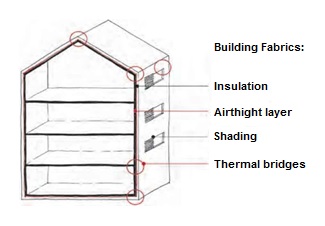
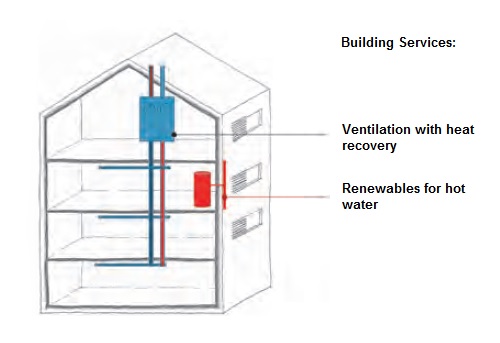
The Passive House Principles: Improved Building Envelope, Ventilation with Heat Recovery (Source: BASF)
A Passive House can be certified by PHI or their certification partners worldwide to ensure the quality standards are met. For example, this certification helps to make sure that it reaches the required energy standard, and indirectly also provides assurance of the construction quality. Because reaching Passive House standards requires extreme dedication to every detail in construction, Passive House buildings achieve excellent construction quality standards, which often also result in reduced maintenance costs.
Examples in Asia
While the first examples of Passive Houses were all small buildings, constructed in northern climate zones, the concept is now spreading all over the planet and is used for large-scale buildings, too. The PHI, among others, has conducted studies on adapting the concept to all climate zones, and several examples have already been constructed and are being monitored.
Korea and Japan
As most of the South Korean and Japanese climate zones are very well suited for this standard, the concept was quickly adopted there, and several Passive Houses have been registered with PHI. Passive Houses are viewed as highly desirable: one Japanese company for prefabricated houses recently extended their portfolio to include this building concept.
Chinese Passive House Projects
In China, as the Passive House concept was explicitly recommended in the 13th Five Year Plan, leading to high interest in the topic and several pilot projects. The additional benefit of good indoor air quality has also created int erest in the Passive House construction method.
The first ever certified Passive House in China was the Hamburg House in Shanghai, which was constructed in 2010 as an office building. For this showcase building, innovative insulation materials, high performance windows, airtight layers and efficient building services were utilized, none of which were standard in the Chinese market. Therefore, the building also served as a learning project for all of the building experts involved.
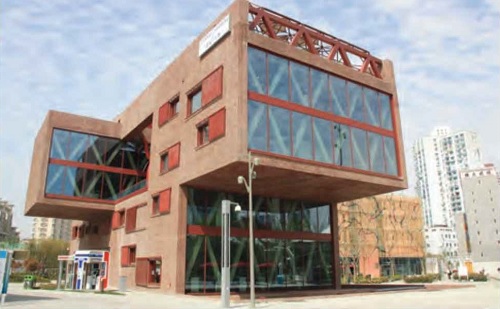
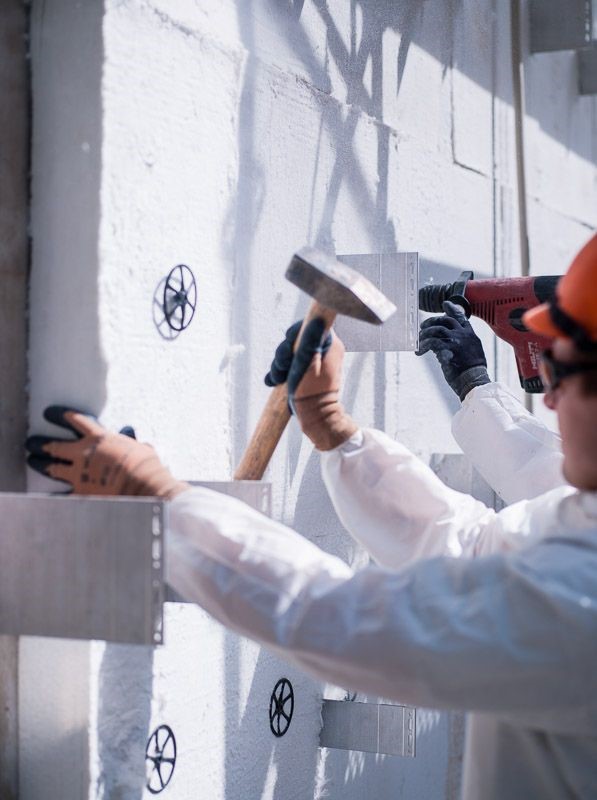
The Hamburg House: Thin and Efficient Insulation for the External Walls (left). Slentex ® Insulation for Space Saving (right).
The first certified Passive House for the hot summer and cold winter climate of the Yangtze River Delta region in China was a hotel. In addition to being constructed according to the Passive House principles, the building was also certified according to three sustainability standards - China Three Stars Green Building Evaluation Standard, DGNB (German Sustainable Building Certificate) and LEED (Leadership in Energy and Environmental Design).
As there is a high demand for construction according to the Passive House standard, due to energy efficiency targets as well as due to improved indoor air quality, there are currently many projects in the planning phase.
A very interesting development will be the first high-rise Passive House, currently under development in Tianjin. This project recently received Pre-Certification by the PHI. This building will show the adaptability of the Passive House concept to standard building archetypes. It will most likely lead the way from showcase houses to standard construction on a larger scale.
With the growing numbers of buildings constructed according to Passive House principles, the availability of innovative construction solutions is also increasing and the costs for these solutions are dropping
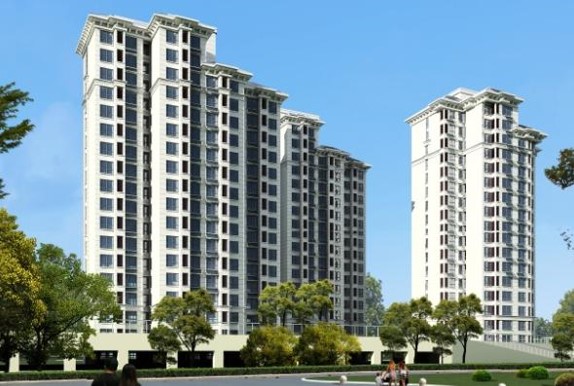
Plannign for the First Certified Chinese High Rise Passive House
When will there be the first Passive House in Hong Kong, Asia's World City?
Although Hong Kong in many areas is seen as a technology and innovation leader, the city has yet to construct its first Passive House. Even though there are sustainable buildings being constructed in Hong Kong, none of these is being built according to the Passive House standard. Considering the extremely high electricity consumption of the building sector, the savings potential is compelling. Adding the advantage of good indoor air quality, it can only be a matter of time until the first Passive House is constructed in Hong Kong - which will serve as a showcase for others to come. The conditions are right: there is a high demand for comfortable, high-quality dwellings; rising awareness of sustainability is making people look for energy-efficient buildings; and the construction sector is technologically ready to take on this new task.
Hong Kong's climate is suitable for constructing a Passive House. Even a typical Hong Kong high-rise building in a dense neighborhood could implement the standard, as in contrast to other climates, the building would not need to receive significant solar gains to heat it up in winter. The few cold days in winter could easily be covered in this well insulated building by the heat recovering unit. In summer, shading in a densely-inhabited area could help the building keep cool, and in combination with good insulation, the air inside the dwellings would stay comfortably cool.
So why has this concept been so well received in mainland China, but not in Hong Kong? Do construction experts believe that insulation works only to keep out the cold? Many examples worldwide prove the opposite. If Hong Kong wants to position itself as a leader in sustainable construction, it is time for Hong Kong to build its first Passive House.
Article contributed by Anne Jacos, Senior Expert, Sustainable Construction, BASF, for the German Chamber of Commerce, Hong Kong (GCC), Commerce and Communication to the Point, Issue 1, 2017.


